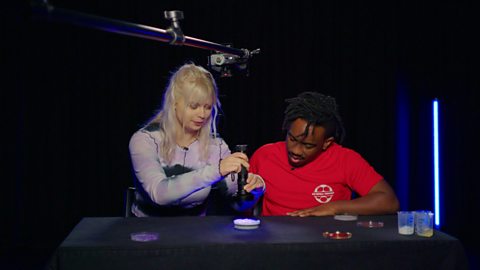Frankie:
Why are we outside?
Louise:
Oh, well, I was just wondering do people with longer legs jumpfurther?
Frankie:
It still doesn't explain why we're outside.
Louise:
Oh sorry yeah, we're here to see them.
Frankie:
Oh wow!
Frankie:
I'm officially interested but the question is, can people with longerlegs actually jump further?
Louise:
Well, I think it's time for an investigation, let's go.
Louise:
We're trying to find out whether people with longer legs jumpfurther. For this experiment, all we need is a measuring tape tomeasure the length of our legs and how far we jump. Some space tojump. And some volunteers, unlike the long jumper we saw earlier,will jump from a standing position because we don't want ourvarying running speeds to affect the results. We'll try three jumpseach and record our results on a scatter diagram. Let's get started!
Sports Commentator:
Today two jumpers go head to head to find out once and for all dopeople with longer legs jump further? In the blue corner with legsthat are 81 centimetres long from hip to floor: Frankie! And in thered corner with legs that are 97.5 centimetres long from hip tofloor: Louise! Let's get jumping.
Louise:
Give it a go.
Frankie:
Ah. Okay. Oh.
Louise:
Woo! Woo!
Louise:
Good game.
Frankie:
Good game.
Frankie:
So how are we going to analyse all of this?
Louise:
Well, we could use a scatter diagram.
Frankie:
A scatter diagram?
Louise:
Yes so a scatter diagram is a great way to take a lot of data anduse it to spot trends. To do this you'd have your change variables atone side, which for us is the leg length. The measure variable downthe bottom, which the distance that we jump. So for example, myleg length is 97.5 centimetres and I jumped 1.85 metres. So we putthe dot there.
Frankie:
OK so should we put dots on all of our jumps then?
Louise:
So I guess people with longer legs do jump further then.
Frankie:
I thought this might happen. So what I did, I got the crew to do thesame jumping experiment as we did, just so we can get more data.So why don't we just put that information into the scatter diagramto see what it tells us?
Louise:
We've been trying to find out whether people with longer legs jumpfurther. And we learnt that amongst the group of people that wetested, people with longer legs do tend to jump further, althoughnot always. Investigations like this are great for helping us learnabout the world around us. Remember, you need a change variable,a measure variable and a way of controlling your experiments tomake it a fair test.
Frankie:
So what are you waiting for?
Video summary
After watching an athlete jumping, presenters Frankie and Louise decide to investigate whether people with longer legs can jump further.
For this investigation, they set up a pattern-seeking enquiry. This involves them both taking three jumps and recording the results in a scatter diagram.
To make the results as accurate as possible they ask the rest of the crew to do the same jumping experiment.
They discover that generally people with longer legs can jump furthest… but not always.
This short film is from the В鶹№ЩНшКЧТіИлїЪ Teach series Experiments in controlled environments.
Teacher Notes
Before Watching
Ask your children to jump up and down on the spot. Ask them to think about which parts of their body they were using. Can they name the leg bones that are moving as they jump?
In this film our presenters want to know, 'Can people with longer legs jump further?' Ask the children what they think? Do they think there will be a pattern, that people with longer legs can jump further?
After Watching
Talk about the film. How did the presenters ensure that their results were reliable? They did three jumps each and took an average. If your learners are not able to work out an average, you could do three jumps and look for the most common result.
Ask your learners to think about which variables they could control in this investigation and which cannot be controlled. The presenters were careful to always jump from the same place, to do the same style of standing jump and to measure the jumps using the same equipment. However, in this investigation there are variables that cannot be controlled, such as age and fitness.
Do you think that people with longer legs can jump furthest? How could you prove or disprove this idea? Consider how other factors, such as age and fitness, might affect how far someone can jump.
Later on in the film, our presenters add the crew’s jump data to the scatter diagram. Why did they do this? How does this help prove or disprove the pattern?
Try the investigation out. Your learners could investigate alternative questions such as:
- Can older people jump further?
- Can people with larger feet jump further?
- Can you jump further with your arms by your sides or arms out stretched?
Ideas for further learning
Sports scientists study how the human skeleton works. They use this information to help athletes to perform even better in competitions. Find out more about sports science, find a way to share your research with others.
Research how far animals can jump. Which parts of their skeletons do they use to help them jump? Compare three different animals – what is similar or different about the way they jump?
Key Scientific Ideas
- Bone – bone is a living tissue with a blood supply and nerves. Bones cannot move or maintain their position without muscles to support them.
- Skeletons – the human skeleton has over 200 bones which support your body, protect your organs and help you to move. The bones of the skeleton meet at joints. There are different types of joints; including hinge joints (e.g., knee) and ball and socket joints (e.g., hips). Some joints are fixed and do not allow movement (e.g., skull).
- Muscles – muscles are attached to bones by tendons. Muscles help bones to move. When a muscle contracts (bunches up), it gets shorter and so pulls on the bone it is attached to. When a muscle relaxes, it goes back to its normal size. Muscles have to work in pairs to move a joint. One muscle will contract and pull a joint one way and another muscle will contract and pull it the other.
Developing practical enquiry skills
Pattern-seeking enquiries – in a pattern-seeking enquiry, learners choose two variables and investigate the relationship between them, looking for patterns; this differs from a fair test because they are not looking for a cause-and-effect relationship. Many pattern-seeking enquiries will lead to a survey, where learners can plot and compare discrete points of information alongside one and other. In these cases, a scatter diagram can be a useful tool for highlighting relationships between the two variables.
Scatter diagrams - these show the relationship between two variables. By looking at the diagram you can see whether there is a link between variables. If there is a link it is called correlation. When the values increase together there is a positive correlation. When one value decreases as the other increases there is a negative correlation.
Repeat measures – we repeat our readings to enable us to gather more data. Each measurement is often a little bit different and so repeat readings allow to gather more reliable results. Repeat readings allow us to take an average.
These short film clips support teachers with practical enquiry. They can be both used as a resource for learners to watch at home or as a stimulus to support learners to plan and conduct their own science investigations. They link to the UK Science curricula.
Science enquiry / Skills for working scientifically
- Pupils should plan different types of scientific enquiries to answer questions, including recognising and controlling variables where necessary.
- Pupils should take measurements, using a range of scientific equipment, with increasing accuracy and precision, taking repeat readings when appropriate.
- Pupils should record data using tables.
Human Body – Skeletons
- Pupils will learn that humans have skeletons and muscles for support, protection and movement.
What temperature does yeast grow the most? video
In this short film presenters Harry and Frankie conduct an experiment to find out the best temperature to activate yeast for breadmaking.
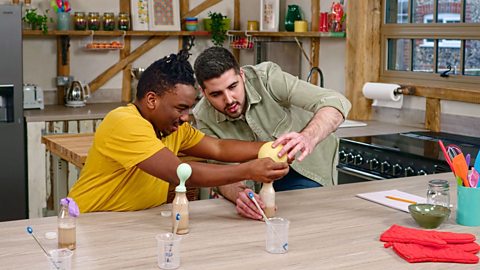
Which material is the most effective insulator? video
In this short film presenters Harry and Frankie find out whether wrapping ice stops it from melting and if so, which material works best.
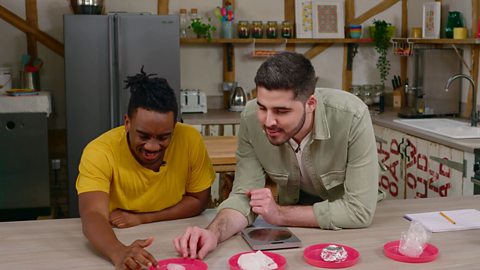
Which soil holds the most water? video
Presenters Harry and Cayana experiment with three samples of soil to find out which holds the most water.
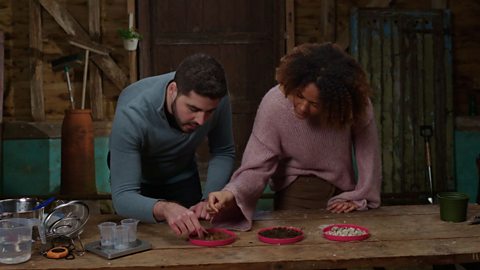
How much gas is there in a bottle of fizzy drink? video
Presenters Harry and Cayana devise an experiment for measuring how much gas is in a bottle of fizzy drink.
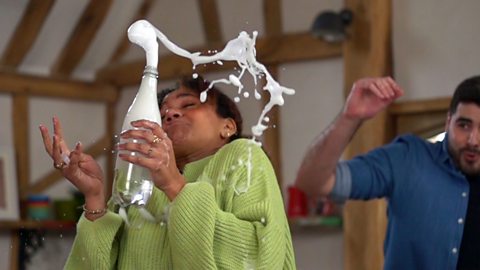
Which is the strongest magnet? video
In this short film, presenters Cayana and Louise test some magnets to find out which one is strongest.
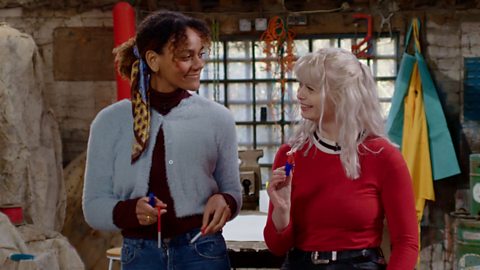
How effective are different liquids at blocking out UV light? video
In this short film, presenters Frankie and Louise find out how effective different liquids are at blocking out UV light.
